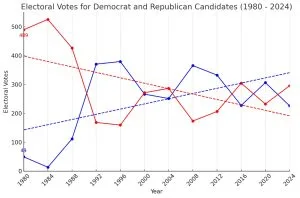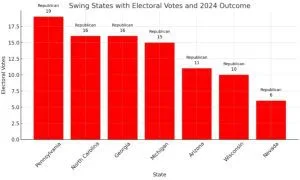Republican Presidential nominee Donald Trump has made a historic comeback to the U.S. presidential office, popularly known as the White House. He will be the first U.S. President in 130 years to serve a second non-consecutive term, and only the second in the history of U.S. presidential elections to do so. Before him, Democrat Grover Cleveland served as U.S. President from 1885 to 1889, and his second term, like Donald Trump’s, came after four years, in 1893.
Donald Trump has so far secured around 51% of the popular vote, winning 295 electoral votes—25 more than the majority mark of 270 needed to win the race. In contrast, Democrat Kamala Harris has secured 226 electoral votes along with 47.5% of the popular vote, according to CNN projections.
As per the U.S. Electoral College, composed of 538 electors, the outcome of the presidential election is determined by a candidate needing 270 votes to secure victory. This number represents the voting membership of the U.S. Congress, which includes 435 Representatives, 100 Senators, and three electors from the District of Columbia. The Electoral College system generally follows a “winner-takes-all” approach, meaning the candidate who wins the popular vote in a state receives all of that state’s electoral votes. This system is used by 48 of the 50 states, with Maine and Nebraska being exceptions. These two states use a proportional system, allocating their electoral votes based on the popular vote distribution within the state.
1980 TO 2024
An analysis of electoral data since 1980, when Ronald Reagan was elected U.S. President, shows that Donald Trump has gained impressive numbers in terms of popular vote share.
Reagan, the only movie actor to later become a U.S. President, was one of the most popular leaders the U.S. has ever seen. During his first successful election, he won 50.75% of the votes with 489 electoral seats, which increased to 58.77% in 1984 with 525 electoral votes, compared to the 13 electoral votes won by Democrats. It was another electoral landslide after 1980 that solidified Republican dominance in the US political landscape during the 1980s. After him, George H.W. Bush received 53.37% of the votes in 1988 but could not secure a second term in 1992. Before losing the 1992 election, his approval ratings had fallen to 34% in the Gallup poll.

However, the political tide in the U.S. began to turn in the 1990s, with Democrats gaining an upper electoral position. Democrat Bill Clinton won the 1992 election with 370 electoral votes compared to the Republicans’ 168. Clinton’s popularity continued into the next election in 1996, where Democrats further widened their lead, securing 379 electoral votes while Republicans dropped to 159. The 1992 election saw a popular vote share difference of 5.5%, which increased to 8.5% in 1996.
Republicans made a comeback in 2000 under George W. Bush, son of former President George H.W. Bush, but it was a close contest. He won just five more electoral votes than Democratic nominee Al Gore. In terms of popular vote share, Bush’s total vote share was 0.51% less than Al Gore’s. He performed better in 2004, winning 35 more electoral votes and crossing the 50% threshold in popular vote share.
From 2008 to 2016, Democrats again dominated the elections, with Barack Obama winning two terms comfortably over Republican candidates, both in terms of vote share and electoral votes. Election outcome numbers say it was an absolute domination. Republicans made a comeback in 2016 under Donald Trump, who won 304 electoral votes against Democrat Hillary Clinton’s 227. However, in terms of popular vote share, the outcome was similar to George W. Bush’s 2000 election—Trump received 2.1% fewer popular votes. In 2020, Trump failed in his re-election bid, with Democrat Joe Biden assuming office.
In his second re-election bid, which turned out to be successful, Donald Trump performed better. He is the second Republican candidate since 1992 to cross the 50% popular vote threshold. Before him, George W. Bush received 50.73% of the vote in 2004. According to Sky News projections, Trump is expected to surpass his 2016 total of 304 electoral seats as the counting concludes.
SWING STATES, TOO, WELCOME TRUMP
Seven key swing states—Arizona, Georgia, Michigan, Nevada, North Carolina, Pennsylvania, and Wisconsin—together hold a significant 93 electoral votes. Donald Trump has won all of them, adding a crucial 93 votes to his tally of 295.
Pennsylvania, with its 19 electoral votes, has typically went Democratic since 1992. However, in 2016, Republican Donald Trump broke this trend by winning the state, highlighting its swing potential. In 2020, Joe Biden reclaimed it for the Democrats, winning by a margin of 82,000 votes. In 2024, Trump has reclaimed it again. He has received 50.4% of the vote, according to CNN projections, against Kamala Harris’s 48.5%, and is ahead by 133,000 votes. In the Senate election race, Republican nominee Dave McCormick is ahead of Democratic nominee Bob Casey by over 30,000 votes.
Michigan also has a history of voting Democratic since 1992, but like Pennsylvania, it shifted to Republican in 2016 with Trump’s victory. Biden won it back in 2020 with a lead of 150,000 votes. Like Pennsylvania, Trump is reclaiming it again. So far, he has received 49.8% of the popular vote against Kamala Harris’s 48.3% and is ahead by 84,000 votes. In the Senate election race, a neck-and-neck fight is being observed, with the Democratic candidate slightly ahead.
Similarly, CNN projects Trump as the expected winner in Wisconsin, a Democratic stronghold since 1988. Trump also won the state in 2016. Biden narrowly won Wisconsin in 2020 by 21,000 votes, but Trump is now ahead of Kamala Harris by over 28,000 votes.
Nevada, though smaller with six electoral votes, is often considered a bellwether state due to its tendency to vote for the eventual winner. Contrary to this trend, it voted for Democrats in 2016, even though the Republican candidate won the presidency. In 2020, Biden secured Nevada with a 34,000-vote lead, while this year, Trump is projected as the expected winner with a lead of over 50,000 votes against Kamala Harris.
Arizona has traditionally been a Republican state since 1952, with exceptions in 1996 when Democrat Bill Clinton won, and in 2020 when Biden edged out Trump by a mere 10,000 votes, a 0.3 percentage point difference. This year, Trump has reclaimed the state and is currently ahead of Kamala Harris by 135,000 votes.
Georgia, holding 16 electoral votes, has generally voted Republican since 1972. Notable Democratic wins include Jimmy Carter in 1976 and 1980, Bill Clinton in 1992, and Joe Biden in 2020, who won by just 13,000 votes—a 0.2 percentage point margin over Trump. Trump is projected to win this year with a margin of over 115,000 votes.
North Carolina usually goes Republican, with Democratic victories being rare since 1964. Jimmy Carter won the state in 1976 and Barack Obama did so in 2008. Trump maintained Republican control in both 2016 and 2020, and 2024 is no exception. He has received 51% of the popular vote here against Kamala Harris’s 47.7%, and is ahead by over 190,000 votes.
Understanding swing states is crucial for anyone interested in U.S. elections. These states often become the focal point of campaigns, with candidates investing significant time and resources to win over undecided voters. As political landscapes evolve, the importance of swing states remains a defining feature of presidential races, holding the power to sway the election’s outcome, and the current results in these swing states add to Trump’s increasing appeal.
The outcome in these states this time reflects Trump’s increased popularity among the voting masses. With almost equally divided Republican and Democratic opinions in these states, Trump was able to convince more voters there to support him.
An August 2023 Pew Research report states that Republicans and Republican-leaning independents consider two Republican presidents as the best in office in the last 40 years, with Donald Trump being one of them, alongside Ronald Reagan. Forty-one percent consider Reagan the best, while 37% chose Trump. The 2024 election outcome says the US population supporting him is expecting the same from him.
By: Santosh Chaubey (DD News)

